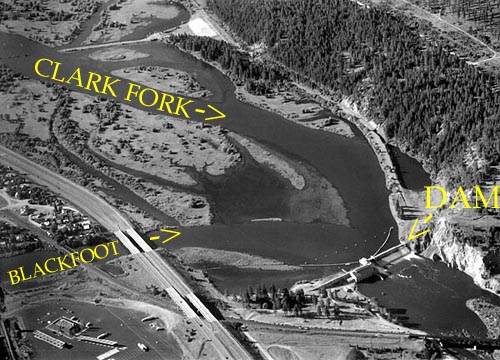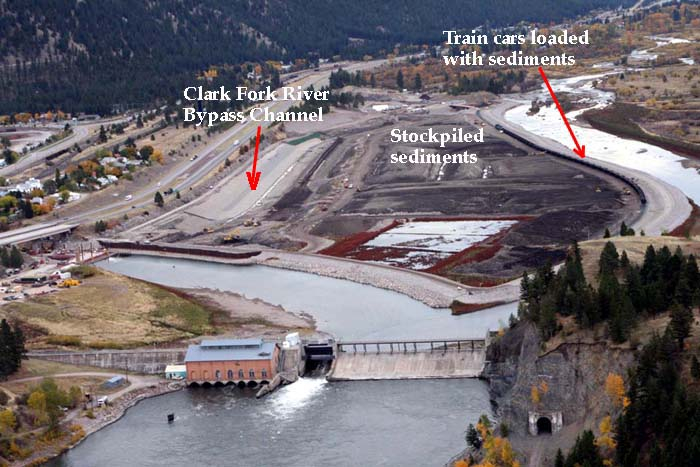|
Dam Controversy
Near Missoula 
Photo courtesy of
the Clark Fork Coalition Everybody lives downstream . . .
The
Milltown Dam, located near the confluence of
the Blackfoot and Clark Fork Rivers, has been a focal
point of controversy in the Missoula area.
Since the dam was completed in 1907, over
6.5 million cubic yards of sediment were deposited on the bottom of the reservoir behind
the dam. Unfortunately these sediments
contained an abundance of arsenic and other
heavy metals from mining activity in the
Butte-Anaconda area. In some places the
sediments were 25 feet thick beneath the
reservoir. Starting in the 1800s, mining and
smelting in the Upper Clark Fork Basin by the
Anaconda Copper Company produced
tremendous amounts of loose rock material (called tailings)
that contained arsenic and heavy metals.
Flooding caused by heavy rains in 1908 is
blamed for transporting huge amounts of
these materials to the reservoir.
Poisoned wells . . .
Pressure caused by the weight of the water
forced water into the contaminated sediments,
pushing arsenic into the groundwater. As a
result several private wells were
contaminated. The Environmental
Protection Agency (EPA) determined the only way to
remove the weight was to remove the reservoir, which meant removing the dam. In the early part of this century the EPA announced plans
to remove the dam and restore the confluence
to its natural state. Plans also call for removal
of about half of the sediment and storage of
these in a permanent repository (storage area where they will not threaten natural water systems). The cost of
this project was estimated to be $90 million.
A bad investment . . .
As a result of a 1977 merger with the
Anaconda Company, Atlantic Richfield
Company (ARCO) is responsible for paying to
clean up the reservoir. For several years
ARCO contended that it would be better to
remove the contaminated sediments while
keeping the dam in place. While the
"dam-in-place alternative" scored higher in
terms of its cost, its ease of implementation,
and its lack of short-term impacts, the EPA
believed that the only permanent solution was to
remove both the dam and the sediments.
Update . . .
The photo below shows how far the clean-up had progressed by October of 2008 . The toxic sediment was/is hauled by train to a repository near Anaconda where it will be kept (capped by) a field of grass. In March of 2008 the bypass channel was used to divert the stream around the dam so that the dam and powerhouse could be removed. To watch a 4-minute video that shows how they diverted the stream, CLICK HERE. The Milltown Superfund Site clean-up project is scheduled to be finished by 2011.  Photo courtesy of Kris Cook of Envirocon
Term: repository
| 





